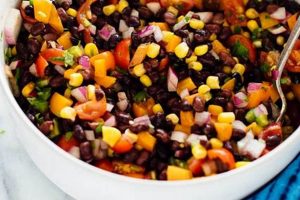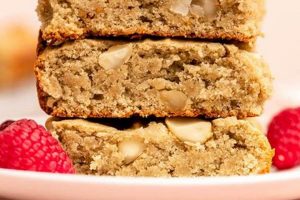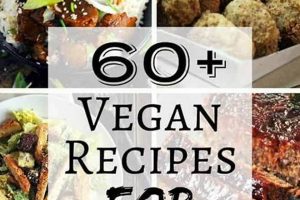A formulation for preparing potato pancakes without animal products involves substituting traditional ingredients with plant-based alternatives. This culinary adaptation addresses dietary restrictions and ethical considerations. For example, using flaxseed meal mixed with water replaces eggs as a binding agent. Applesauce may also serve this function while adding a subtle sweetness.
The rise in popularity of this approach reflects a broader shift towards plant-based diets. It allows individuals to partake in cultural traditions, such as Hanukkah, while adhering to personal values. Furthermore, utilizing plant-based options often contributes to a lower environmental impact and can be beneficial for cardiovascular health due to reduced cholesterol intake.
The following sections will detail the specific components and methods required to create these potato pancakes, offering guidance on selecting the most suitable ingredients and techniques for optimal flavor and texture. Guidance will be provided on adjusting the recipe to accommodate varying tastes and dietary preferences.
Essential Guidance for Plant-Based Potato Pancake Preparation
Achieving optimal results in the creation of animal-product-free potato pancakes requires careful consideration of ingredients and techniques. The following points offer specific guidance to enhance the outcome of this culinary endeavor.
Tip 1: Potato Selection: Starchy varieties, such as Russet potatoes, yield a superior texture. Their high starch content aids in binding and creates a crispy exterior.
Tip 2: Moisture Management: Excess moisture is detrimental to achieving crispiness. Thoroughly draining and squeezing grated potatoes is crucial. A cheesecloth or clean kitchen towel may be employed for effective moisture removal.
Tip 3: Binding Agent Alternatives: Flaxseed meal combined with water (a flax egg) or applesauce serves as an effective substitute for traditional eggs. Consistency is key. Allow the flaxseed mixture to thicken before incorporating it into the batter.
Tip 4: Oil Temperature Control: Maintaining a consistent oil temperature, typically between 350-375F (175-190C), is essential for even cooking and proper browning. Use a thermometer to monitor the temperature accurately.
Tip 5: Batch Cooking: Overcrowding the pan lowers the oil temperature, resulting in soggy pancakes. Cook in smaller batches to ensure consistent heat and optimal crispness.
Tip 6: Seasoning Precision: Seasoning should be adjusted to taste, but a balance of salt, pepper, and potentially a touch of onion powder enhances the overall flavor profile. Incorporate herbs such as chives or parsley for added complexity.
Tip 7: Serving Immediately: These pancakes are best enjoyed immediately after cooking, while they are at their peak crispness. If necessary, keep them warm in a low oven (around 200F or 95C) on a wire rack to prevent them from becoming soggy.
By adhering to these principles, one can significantly improve the quality and enjoyment of plant-based potato pancakes. Attention to detail throughout the preparation process contributes to a more satisfying culinary experience.
The concluding section will provide ideas for complementary accompaniments and serving suggestions to further enhance the presentation and taste of the dish.
1. Potato Variety
The selection of a specific potato variety significantly influences the final texture and flavor profile of animal-product-free potato pancakes. This choice impacts the structure, moisture content, and overall culinary experience.
- Starch Content and Texture
Potato varieties with high starch content, such as Russets and Yukon Golds, yield a crispier exterior due to the starch gelatinizing during frying. Low-starch varieties, such as red potatoes, tend to produce a softer, less defined texture. The desired textural outcome dictates the optimal potato choice.
- Moisture Levels and Binding
Varieties with lower moisture content require less effort in draining excess liquid, resulting in a batter that binds more effectively. High-moisture varieties necessitate rigorous moisture removal to prevent a soggy end product. The ease of preparation is influenced by this factor.
- Flavor Nuances and Compatibility
Different potato varieties possess distinct flavor profiles. Russets offer a mild, earthy flavor, while Yukon Golds exhibit a subtly buttery taste. The flavor profile must complement the other ingredients and desired overall taste. Experimentation with various types is essential to determine the preferred balance.
- Impact on Cooking Time
Due to varying densities and starch levels, different types of potatoes will cook at different rates when fried. Starchy potatoes tend to brown more quickly due to the carmelization of sugars released during cooking. It is important to adjust cooking times and temperatures accordingly to ensure that the potato pancakes are fully cooked through without burning the outside.
Consequently, the judicious selection of potato variety directly impacts the textural attributes, flavor nuances, and preparation process. Considerations for starch content, moisture level, and taste must guide the decision-making process to achieve optimal results in preparing animal-product-free potato pancakes.
2. Binding Agent
In the preparation of animal-product-free potato pancakes, the binding agent serves a critical function, replicating the cohesive properties traditionally provided by eggs. This ingredient is essential for preventing the batter from crumbling during cooking and maintaining the desired structural integrity of the final product.
- Flaxseed Meal (Flax Egg)
Flaxseed meal, when combined with water and allowed to sit, forms a viscous substance that mimics the binding properties of eggs. Typically, one tablespoon of flaxseed meal is mixed with three tablespoons of water. This mixture can replace one egg in the potato pancake recipe. The resulting pancakes exhibit a slightly nutty flavor and a cohesive texture.
- Applesauce
Unsweetened applesauce functions as an alternative binding agent, adding moisture and a subtle sweetness to the potato pancakes. Approximately one-quarter cup of applesauce can be used as a replacement for one egg. While applesauce contributes to binding, it may also influence the overall texture, resulting in a slightly softer pancake.
- Potato Starch
Adding potato starch directly to the grated potato mixture enhances its binding capabilities. The starch absorbs excess moisture and creates a more cohesive batter. This is particularly beneficial when working with potato varieties that have a high water content. Approximately one to two tablespoons are typically added. This avoids adding additional flavours to the latke.
- Chickpea Flour (Besan)
Chickpea flour, also known as besan, can serve as a binding agent while contributing a subtle nutty flavor. It also assists in creating a slightly crispier texture when fried. The flour is mixed directly into the grated potato mixture in small increments until the desired consistency is achieved. This option can provide a distinct flavor profile compared to other binding agents.
The choice of binding agent influences not only the structural integrity of the potato pancakes but also their flavor and texture. Experimentation with different binding agents allows for customization based on individual preferences and desired culinary outcomes. The successful substitution of traditional eggs is paramount to creating a satisfactory animal-product-free version of this dish.
3. Oil Temperature
Oil temperature is a critical variable in the successful execution of a plant-based potato pancake preparation. The thermal energy of the cooking oil directly influences the Maillard reaction, responsible for the development of the desired golden-brown color and crispy texture. Insufficient oil temperature results in the absorption of excessive oil, leading to a soggy and unappetizing outcome. Conversely, excessively high oil temperature causes rapid browning on the exterior while leaving the interior undercooked, rendering the pancake uneven and undesirable. A stable oil temperature within the optimal range is therefore essential for achieving a balanced and texturally pleasing final product.
Maintaining a consistent oil temperature is particularly challenging in plant-based versions due to differences in moisture content and ingredient composition. For example, using applesauce as a binding agent introduces additional sugars, which can cause more rapid browning and require careful monitoring of the oil temperature to prevent burning. Furthermore, the absence of egg proteins, which contribute to structure and stability, necessitates precise temperature control to ensure the pancakes hold their shape and achieve the desired crispness. Using a thermometer to monitor the oil and making small adjustments to the heat as needed is crucial. Plant-based potato pancakes often require slightly lower or more closely monitored oil temperatures compared to traditional recipes.
In summary, achieving the desired color, texture, and flavor in plant-based potato pancakes hinges on careful oil temperature management. Insufficient heat leads to oil absorption and sogginess, while excessive heat causes uneven cooking and burning. Maintaining a consistent and optimal temperature is essential for compensating for the unique characteristics of plant-based ingredients and ensuring a delicious and well-prepared final dish. Successful plant-based potato pancake preparation necessitates an understanding of the interplay between ingredient composition and thermal dynamics.
4. Moisture Control
Moisture control is a paramount consideration in the preparation of animal-product-free potato pancakes. Excess moisture inhibits browning and crisping, leading to a soggy, undesirable texture. The manipulation of moisture levels, therefore, directly impacts the success of the recipe.
- Grated Potato Drainage
Grated potatoes inherently contain a significant amount of water. Immediately after grating, the potatoes must be thoroughly drained. This can be accomplished by placing the grated potatoes in a colander and pressing out the excess liquid. A cheesecloth or clean kitchen towel can be used to further extract moisture. Insufficient drainage results in a wet batter that fails to crisp during cooking.
- Binding Agent Adjustment
The selection and quantity of the binding agent should be calibrated based on the moisture content of the potatoes. If the potatoes remain excessively wet despite drainage efforts, a greater proportion of dry binding agent, such as potato starch or chickpea flour, may be necessary. Over-reliance on liquid binding agents, like applesauce or flax “eggs,” can exacerbate the moisture problem.
- Ingredient Selection and Preparation
Other ingredients added to the potato pancake batter, such as onions, can contribute to the overall moisture content. Thoroughly sauting onions before incorporating them into the batter can reduce their water content. Selecting potato varieties known for their lower moisture levels can also mitigate the issue.
- Frying Technique Modification
The frying technique itself can be adjusted to compensate for residual moisture. Maintaining a higher oil temperature, within safe limits, promotes faster evaporation of water. Cooking in smaller batches prevents overcrowding and allows for more efficient moisture release. Patting the formed pancakes dry with a paper towel before frying can remove surface moisture.
The interplay of drainage techniques, binding agent selection, ingredient preparation, and frying method collectively dictates the final moisture content of animal-product-free potato pancakes. Mastery of these techniques is essential for achieving the desired crispy exterior and avoiding a soggy, unappetizing result. The manipulation of these variables allows for adaptability to different potato varieties and environmental conditions, contributing to a consistently successful outcome.
5. Seasoning Balance
The success of a plant-based potato pancake hinges significantly on the equilibrium of seasonings. Proper seasoning elevates the dish beyond mere sustenance, transforming it into a flavorful and satisfying culinary experience.
- Salt Enhancement
Salt plays a critical role in enhancing the inherent flavors of the potatoes and other ingredients. Insufficient salt results in a bland and unremarkable dish, while excessive salt overwhelms the palate. The appropriate quantity of salt unlocks the full potential of the potato’s earthy notes, onion’s pungency, and any other herbs or spices used. Himalayan pink salt, sea salt, or kosher salt are acceptable.
- Pepper Complexity
Pepper provides a layer of complexity and subtle heat. Black pepper is the most common choice, adding a warm, slightly spicy flavor. However, other varieties, such as white pepper, offer a milder, more refined heat. Freshly ground pepper is preferable, as it releases more aromatic oils and delivers a more intense flavor. Experimentation with different pepper varieties allows for nuanced adjustments to the dish’s overall profile.
- Umami Depth
In the absence of animal products, incorporating ingredients that provide umami, the savory fifth taste, enhances the dish’s depth and richness. Onion powder, garlic powder, or nutritional yeast are excellent additions. These ingredients contribute glutamate, an amino acid that triggers the umami taste receptors. The judicious use of umami-rich ingredients elevates the potato pancakes beyond simple starch, adding a satisfying savory dimension.
- Herbal Harmony
The inclusion of fresh or dried herbs introduces aromatic complexity and visual appeal. Chives, parsley, or dill are commonly used, adding bright, fresh notes that complement the potato’s earthiness. Dried herbs should be used sparingly, as their flavors are more concentrated. Fresh herbs should be added towards the end of the cooking process to preserve their delicate aromas. The careful selection and incorporation of herbs contribute to a harmonious and well-balanced flavor profile.
Achieving a harmonious seasoning balance requires careful consideration of the interplay between salt, pepper, umami, and herbs. Each ingredient contributes unique flavor notes that must be carefully calibrated to create a cohesive and satisfying culinary experience. Experimentation and taste testing are essential for fine-tuning the seasoning to individual preferences and ensuring a truly exceptional animal-product-free potato pancake.
6. Serving Suggestions
Serving suggestions function as an integral component of the overall dining experience associated with animal-product-free potato pancakes. The choice of accompaniments directly influences the perceived flavor profile, nutritional value, and cultural relevance of the dish. For instance, a traditional serving of applesauce provides a contrasting sweetness that balances the savory nature of the pancakes. Conversely, plant-based sour cream alternatives offer a creamy, tangy counterpoint, enhancing the texture and enriching the overall taste. The strategic selection of serving suggestions, therefore, elevates the basic potato pancake from a simple preparation to a complete and satisfying meal.
Furthermore, serving suggestions can adapt the dish to diverse palates and dietary requirements. A sprinkle of fresh herbs, such as dill or chives, adds a vibrant visual element and contributes subtle aromatic notes. A side of pickled vegetables introduces a tangy, acidic element that cuts through the richness of the fried pancakes. For those seeking a heartier meal, incorporating lentil soup or a mixed green salad provides additional protein and fiber. In adapting the dish to unique dietary guidelines and flavour preferences, serving suggestions enhance the overall acceptance of the potato pancake as a plant-based culinary option.
Ultimately, carefully considered serving suggestions are essential to maximizing the enjoyment and versatility of animal-product-free potato pancakes. These accompaniments serve to complement the flavor profile, enhance the nutritional value, and adapt the dish to individual preferences and dietary needs. Attention to serving suggestions transforms a simple preparation into a more nuanced and satisfying culinary experience, thereby increasing the appeal and acceptance of this plant-based adaptation.
Frequently Asked Questions
The subsequent section addresses common inquiries regarding the creation of potato pancakes that exclude animal products. Clarity on these points facilitates a more informed and successful culinary endeavor.
Question 1: What potato varieties are optimal for achieving a crisp texture in animal-product-free potato pancakes?
Starchy potatoes, such as Russets or Yukon Golds, generally yield the most desirable results. Their higher starch content contributes to a crispier exterior when fried. Lower-starch varieties may result in a softer, less texturally contrasting outcome.
Question 2: Can the grated potatoes be prepared in advance?
Grated potatoes tend to discolor if left exposed to air for extended periods. If advance preparation is necessary, submerge the grated potatoes in cold water with a small amount of lemon juice or vinegar to prevent oxidation. Thoroughly drain and dry the potatoes before proceeding with the recipe.
Question 3: What are suitable oil options for frying these pancakes?
Neutral-flavored oils with high smoke points are generally recommended. Examples include canola oil, vegetable oil, peanut oil, or refined coconut oil. Olive oil is not recommended due to its lower smoke point and distinctive flavor.
Question 4: How does one prevent the potato pancakes from sticking to the pan?
Ensure the pan is adequately preheated and the oil is sufficiently hot before adding the potato pancakes. A well-seasoned cast iron skillet or a non-stick pan can minimize sticking. Sufficient oil in the pan is also necessary.
Question 5: Can these potato pancakes be baked instead of fried?
While frying yields the most authentic texture, baking is a viable alternative for those seeking a lower-fat option. Bake at a high temperature (around 400F or 200C) on a baking sheet lined with parchment paper, flipping halfway through the cooking process. Note that baking will not produce the same level of crispness as frying.
Question 6: How long do leftover potato pancakes remain edible?
Leftover potato pancakes should be stored in an airtight container in the refrigerator and consumed within 2-3 days. Reheating in a skillet or oven is recommended to restore some crispness. Microwaving tends to result in a soggy texture.
These frequently asked questions address common concerns and offer practical solutions for preparing animal-product-free potato pancakes successfully. Careful attention to these details contributes to a more rewarding culinary experience.
The subsequent section provides a summarized version of key points relating to the animal-product-free potato pancake recipe.
Animal-Product-Free Potato Pancake Preparation
The preceding discussion has detailed the critical factors in creating potato pancakes devoid of animal products. The selection of appropriate potato varieties, the judicious use of binding agents, precise oil temperature management, rigorous moisture control, balanced seasoning, and thoughtful serving suggestions each contribute to the final product’s quality. Mastery of these elements is essential for achieving a texturally pleasing and flavorful result.
The successful adaptation of traditional recipes to accommodate dietary restrictions and ethical considerations represents a significant evolution in culinary practice. Continued experimentation and refinement of techniques will further enhance the accessibility and appeal of animal-product-free potato pancakes, contributing to a more inclusive and sustainable culinary landscape. It is recommended to explore further variations of the discussed techniques to refine personal culinary skill.







